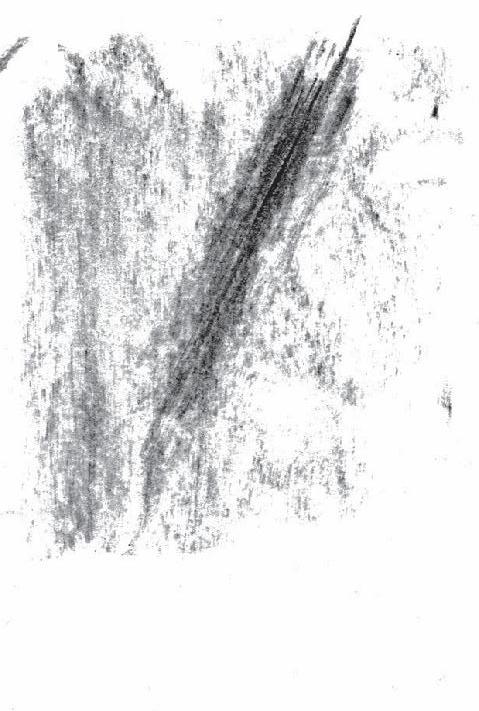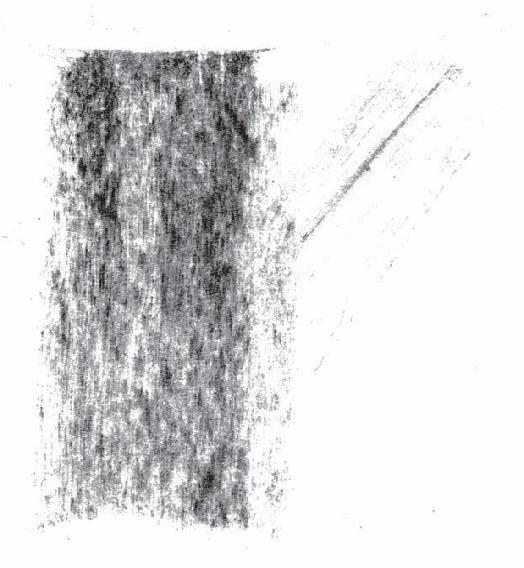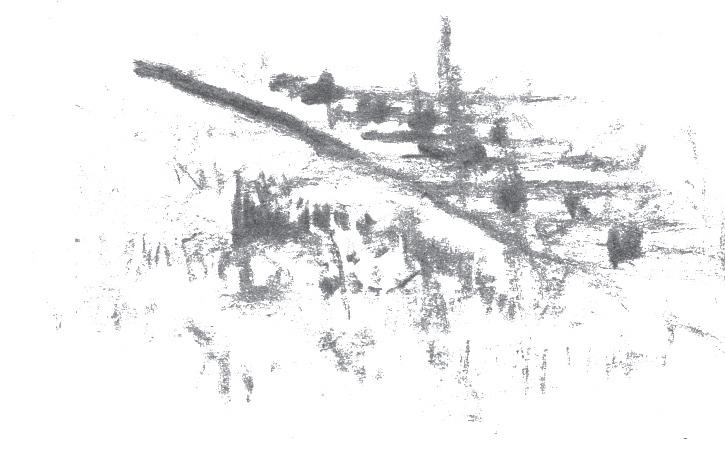
13 minute read
AN ABSTRACT WAY OF EXPERIENCING ARCHITECTURE


Advertisement

Fig.1: The sound is received into the space and informs the receipent.
To experience the absolute silence, John Cage entered into the anechoic chamber. He came out changed: it turned out that the experience of silence is not possible. Cage heard two sounds of different heights (...) generated by his body. The composer was delighted - no music will die while I’m alive.1
Sound is a must for every experience of space, that is why everyone is in constant dialogue with architecture - the human body constantly generates sounds that resound in a specific place, and then come back again thus shaping emotionally rich experiences of being inside architecture. The notion of silence, on the other hand, is usually equated with the conscious or experienced lack of specific sound-signals and a low-frequency background, and not with a physical lack of sounds (which cannot be experienced in nature).


In this context, the silence of architecture can be therefore equated with the death of the city in its semantic meaning - city, which remains only in form of a pile of bricks overgrown with tall grass which slowly changes its status and returns to the nature together with its sounds: wind and rain. Therefore, it can be concluded that the presence of man is the only factor which determines the existence of both silence and sound in architecture, because he is the only one able to give them meaning, receive and generate them.
Silence in architecture can therefore be understood as a strong will of internal meditation, stimulating the imagination to open itself to the attentive process of listening to spaces that contain music in crudo; the latent music waiting to be extracted by those who hear more.2 Martin Heidegger also claims that the practice of silence allows you to tame space, get to know it, identify it, name it, so understand and truly live.3 Architecture
should therefore be a sanctuary of silence, slowness and cultural continuity to defend us against loss of meaning, strengthening our sense of reality and biological and cultural continuity.4 It should sound; be a performance, a place of a spectacle that requires its guest to be fully active - to listen, experience, co-create and experience actively.
AUDIBLE ARCHITECTURE
Contemporary architecture tends to be composed and perceived on the basis of mono-sensory views, with almost complete omission of the key role that other senses play in the experience. This has consequences at both aesthetic and existential levels - the rich transmission of architecture as the art of multi-sensory cognition is reduced and flattened, thereby losing its depth and excluding man from its full experience - one can even speak of a kind of blindness that affects contemporary recipients.5 As Juhani Pallasmaa notes: instead of experiencing our being in the world, we are watching it from outside as viewers of images projected onto the retina of our eye.6 Vision is the dominant medium in the perception of architecture, although it creates with the viewer a relationship based on a distance and superficiality, while hearing enhances the feeling of being inside, immersion in it and continuous communication with it.7 Unlike sight, hearing can create with space an intimate dialogue in which man becomes an equal partner in conversation.
Every building and every space has its distinctive sound of intimacy and monumentality, invitation or rejection, hostility or hospitality.8
It is important, therefore, for the sound to be finally heard and included in the creation of the reception of space because the buildings are not a dead and deaf environment with which man must constantly struggle and impose his sounds. It is necessary to go back in time to understand the attitude of tribal people who with great humility listened to their landscape and let it shape them. In the same way today, buildings and their interiors, through their composition of geometry, material and chiaroscuro creation, want to speak to people and fill them with an infinite number of impressions.
The above considerations regarding (for a change) conscious perception of architecture through the sound character of its space create the auditory architecture of the place, a phenomenon known since the Paleolithic times, which postulates were collected in the book Spaces speak, are you listening? by a couple of Canadian scientists - Barry Blesser and Linda Ruth-Salter. The phenomenon of auditory architecture refers to those features of space that can be experienced by hearing - a composition of planes, objects and geometry that in a complex environment create specific acoustics of the place. In its broadest sense, its definition comprise of any sound or acoustic attribute which boundaries simultaneously form and disappear with the development of sound - their only limit is the acoustic horizon.9 To understand that auditory architecture is an element constantly inherent in the human subconsciousness, just think of translocation of familiar sounds into an unknown environment: moved to an open desert, traffic would no longer have the auditory personality of dense, urban buildings.10
Auditory architecture can also be read in its social sense: the bare marble floors and walls of the office lobby loudly announce the arrival of clients by echoing their footsteps; on the other hand the same room but furnished with thick carpet, padded furniture and heavy draperies will suppress sudden or reflected sounds, thus silencing identical information. Dimensions of the space are in both cases the same but the auditory experience determines whether the entrance to the interior is considered in the context of public or private event.11
By analogy, acoustic design of the space may also shape behaviour and emotions of its users, for example: in a small museum hall, which walls and floor are cladded with stone tiles, the organic shape of a marble sculpture located in the middle will distract all sounds, which consequently will bounce off on and from the walls and get differentiated tones, directions and heights. Such space will be very unclear in terms of auditory perception and thus will generate a sense of uncertainty and anxiety. The interior will create a distant relationship with the observer, imposing on him strict contemplation rather than relaxation, to muted conversations instead of laughter, to leaving instead of staying. However, if the same room with an identical sculpture receives a textile floor and draperies on the walls, its soundscape will completely change: the sounds reflected from the sculpture will be absorbed by the walls material, thanks to which the interior will fill the background with low tones and create a sense of bliss, peace and domestication. It will be easier here for a relax or a loose conversation.
SCENARIO OF SENSUAL EXPERIENCING
I like the idea of arranging the internal structures of my buildings in sequences of rooms that guide us, take us places, but also let us go out and seduce us. (...) I give thought to careful and conscious staging of tension between inside and outside, public and intimate, and to thresholds transitions, borders.12
Implementing the same principles into an urban scale, experiencing of the city in an audible way begins with a single step on a surface that by emitting appropriate sounds can intensify the feelings of which we will not be able to realize, but we will feel better and tell that there is an original atmosphere, which will be the result of a specific acoustic climate.13 The sound of the reverberating steps and their reception depends largely on the acoustic landscape of the space - the ratio of width to height of the building, its compactness and the material used for the facade.
The sound of footsteps in the square fades away among the hum of the mass of people; the multitude of auditory stimuli effectively drowns them out and thus does not allow for longer




Fig.2. Sensual representation of architectural landscapes.
contemplation. Such situation creates a sense of anonymity in the space and also builds a weak emotional relationship with the recipient. A narrow street, on the other hand, has much less traffic, which makes the sounds more readable. The close distance between buildings’ walls creates a resonating well, which amplifies the sound of the person passing by and thus enters into an audio dialogue with him. Consequently, a person starts to feel a desired sense of identity, peace and security. The auditory experience depends to a large extent on the materials: passing by the glass curtain wall, sound footsteps is completely reflected from it, which makes the perception of the street fragment cool and distant. A few meters further however, when we encounter a stone wall overgrown with ivy, the street is already perceived as cosy and domesticated, although its character considered in the context of the entire length has not changed at all.
My dedication to finding the right size of things is motivated by the desire to create degrees of intimacy, of closeness and distance. I love placing materials, surfaces, and edges, shiny and mat, in the light of the sun, and generating deep solids and gradations of shading and darkness for the magic of light falling on things. Until everything is right.14
The medium of water also plays an important role in acoustic experiencing of an urban space. A fountain, pond or a river produce natural, soothing sounds for the ear and therefore, they attract public attention and create spaces which are characterised by spontaneous and diversified sounds. Unfortunately, the urban soundscape is dominated by overlapping sound plans generated by traffic, which are perceived as tiring and drowning out the unique sound of the city. Negative experience of noise is, however, often associated with the inefficient process of listening: the sounds of the engine, wheels passing on the tracks or traffic lights do not have to be part of one great mass attacking a man, but should be heard again as separate sounds that are part of a larger, multi-layered composition, thanks to which the city’s reception will become less burdensome, and many of the sounds will be categorized as signals that build its auditory characteristics.
NEW THEORY OF ARCHITECTURE
Based on the postulates of auditory architecture, one can also ask about the possibility of hearing architecture which means experiencing it by means of sound, but not in the form of a sound installation (which usually has a didactic function of the city’s unusual or forgotten sounds) but by analogy to visual perception. Given the fact that sound information is stronger than visual (due to the uninterrupted listening process), one can hypothesize that audible information of architecture brings more complete information than its image. Is Jan Sebastian Bach’s music and the touch of the profiled detail of the portal able to convey a deeper experience of the reception of the baroque church facade than its photograph? The question about the architectural perception of architecture also refers to the example of the blind who, relying mainly on the sense of hearing, would then be able to hear the difference
in the street between a one-storey house, a four-storey brick building or a ten-storey glass tower. It will be probably easier to hear the difference between a tall glass facade and a low stone wall, but will the difference be also heard when the percentage of windows on the plastered facade will change? If so, is it possible to assume that one can hear the sound of a given street fragment composed of specific buildings arranged in a fixed sequence?
Juhani Pallasmaa believes that each city has its own echo, which depends on the layout and scale of its streets and the dominant architectural style and materials used15 but can this theory be translated into a specific sound which consequently create a melodic line of a given street, district, city?
G. Follmer in his book The sound of the City states that cities nowadays - very different (...) are at risk that they will all sound the same.16 Indeed, the progressive sound globalization of cities can become a huge problem, because it is associated with the gradual blurring of the individual sound characteristics of each of them - a loss of acoustic identity. The postulates of auditory architecture aim at broadening the perspective of multi-sensory experience of space by sensitizing the recipient to its constituent elements and thus building a strong emotional bond that stimulates his imagination and sensitivity. Architecture perceived in this way has a chance to become a spectacle with a variety of material, colour, sound and light stimuli, so that its experience will refer to the deepest memories in form of taste, smell, texture, sound and not only a specific image. Contemporary architecture has more than ever become just a visual forgetting that in contrast to sight, hearing enhances the feeling of being inside architecture, immersion in it and results in communication.17 Being stripped of all the multi-sensory dignity that architecture offers, it damages sensitivity and the aesthetic feelings of the observer. It should be remembered that space is not only evaluated by means of sounds, but above all by the action of imagination, because in itself it has no meaning until it is given to it by a man.//

SOURCES 1 Larson, K. (2000). Louis Kahn: Unbuilt Masterworks. New York, The Monacelli Press. 2 Czaja, D. (2012). Szmery, szepty i krzyki. Muzyka wenecka. In: R. Losiak, R. Tańczuk, Audiosfera Miasta, (p.62). Wrocław, Poland: Wydawnictwo Uniwersytetu Wrocławskiego. 3 Janiak, A. (2007). Zdesakralizowane świątynie ciszy – kościół, cmentarz, muzeum, biblioteka. In A. Janiak, W. Krzemińska, A. Wojtasik – Tokarz, Przestrzenie wizualne i akustyczne człowieka. Antropologia audiowizualna jako przedmiot I metoda badań, (p.248). Wrocław, Poland: Wydawnictwo Dolnośląskiej Szkoły Wyższej Edukacji TWP. 4 Pallasmaa, J. (2010). Architektura w słowach. In J. Kusiak, B. Świątkowska (Eds.), Miasto – Zdrój, Architektura i programowanie zmysłów (p.66). Warszawa, Poland: Fundacja Nowej Kultury Bęc Zmiana. 5 Pallasmaa, J. (2012). Oczy skóry. Architektura i zmysły (p.63). Kraków, Poland: Instytut Architektury. 6 Ibid, p.39. 7 Kłopotowska, A. (2015). Akustyczne obrazy przestrzeni miejskiej. Słuch jako narzędzie emocjonalnego odbioru przestrzeni u osób z dysfunkcją widzenia. In: A. Kłopotowska (Eds.) Dźwięki Architektury (p.194). Białystok, Poland: Oficyna Wydawnicza Politechniki Białostockiej. 8 Pallasmaa, J. (2012). Oczy skóry. Architektura i zmysły (p.62). Kraków, Poland: Instytut Architektury. 9 Leither, B. (2010). Sound architecture – space created through travelling sound. In S. Voegelin, Listening to Noise and Silence: Towards a Philosophy of Sound Art (p.38). NY: The Continuum International Publishing Group Inc. 10 Blesser, B., Ruth-Salter, L. (2016). Spaces speak are you listening? (p.2) MIT Press, Massachusetts. 11 Ibid., (p.3). 12 Zumthor, P. (2010), Thinking architecture (p.86), Basel : Birkhäuser. 13 Siestrzewitowska, M. J. (2015 ). Słuchanie miasta. Dźwięk jako element tożsamości przestrzennej. In: A. Kłopotowska (Eds.), Dźwięki Architektury (p.127). Białystok, Poland: Oficyna Wydawnicza Politechniki Białostockiej. 14 Zumthor, P. (2010), Thinking architecture (p.87), Basel : Birkhäuser. 15 Bernat, S. (2015) Rewitalizacja akustyczna krajobrazu. In: A. Kłopotowska (Eds.), Dźwięki Architektury (p.161). Białystok, Poland: Oficyna Wydawnicza Politechniki Białostockiej. 16 Follmer, G. The Sound of the City. Retrived from http://www. goethe.de/kue/arc/dos/dos/sls/sku/en1515752.html 17 Kłopotowska, A. (2015). Akustyczne obrazy przestrzeni miejskiej. Słuch jako narzędzie emocjonalnego odbioru przestrzeni u osób z dysfunkcją widzenia. In: A. Kłopotowska (Eds.) Dźwięki Architektury (p.194). Białystok, Poland: Oficyna Wydawnicza Politechniki Białostockiej.
Fig.3 Representation of architecture received through the sound.









